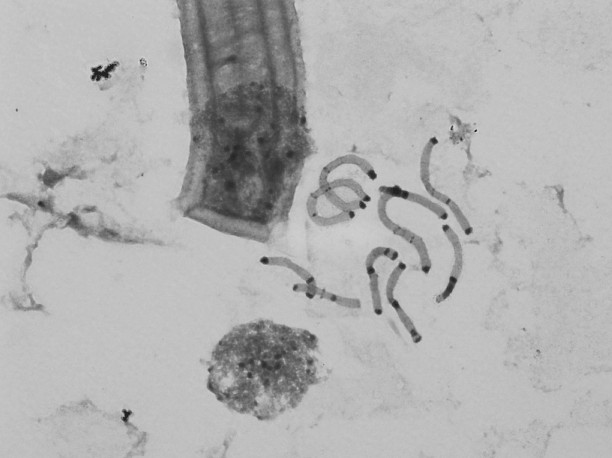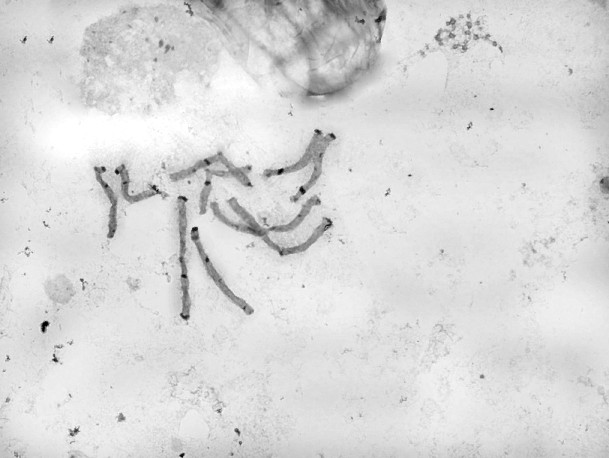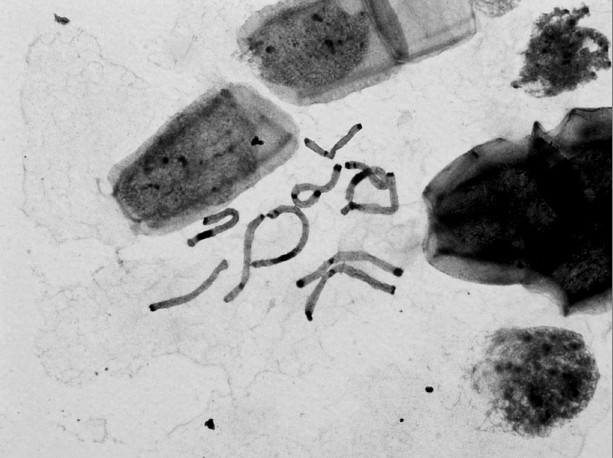Method for dyeing Giemsa-C band of paris plant cell
A technology of plant cells and dyeing methods, which is applied in the field of Giemsa-C band dyeing of plant cells of the genus Pachyphylla, can solve the problems of unstable dyeing color, difficult analysis, and contamination of film production, and achieve simple and easy-to-operate band patterns, The effect of high resolution and low film contamination
- Summary
- Abstract
- Description
- Claims
- Application Information
AI Technical Summary
Problems solved by technology
Method used
Image
Examples
Embodiment 1
[0030] At 10:30, the new white roots of Pachyphysis mosaic plants were taken, and treated in ice-water mixture for 48 hours; fixed with Carnot I for 6 hours, transferred to 70% alcohol, and then stored in a 4°C refrigerator for later use; For a good root tip use 0.2 molL -1 Dissociate with hydrochloric acid at 22°C for 1 hour, wash with distilled water, press with acetic acid with a volume concentration of 45%, and remove the sheet with liquid nitrogen; dehydrate in absolute ethanol for 12 hours, and dry naturally in the room for 2 days; moL -1 Treat in hydrochloric acid for 155s, wash with distilled water; then treat in saturated barium hydroxide solution for 10min, replace and wash with preheated 38°C distilled water until clear, and then wash with 0.05 molL -1 Rinse twice with hydrochloric acid to remove the residual barium carbonate precipitate, and wash the hydrochloric acid with distilled water; after washing, transfer the film to another clean dyeing vat, add 2×SSC, pu...
Embodiment 2
[0033]At 11:30, take the new white root of Huachonglou plant, and treat it in the ice-water mixture for 36 hours; fix it in Carnot Ⅰ for 12 hours, transfer it to 70% alcohol, and store it in the refrigerator at 4°C for later use; use the prepared root tip with 0.2 moL -1 Hydrochloric acid was dissociated at 23°C for 1.5h, washed with distilled water, pressed with acetic acid with a volume concentration of 45%, and removed with liquid nitrogen; dehydrated with absolute ethanol for 12h, and dried naturally in the room for 3d; moL -1 Treat in hydrochloric acid for 155s, wash with distilled water; then treat with saturated barium hydroxide solution for 9min, replace and wash with preheated 38°C distilled water until clarification, and then wash with 0.05 molL -1 Rinse twice with hydrochloric acid to remove the residual barium carbonate precipitate, and wash the hydrochloric acid with distilled water; after washing, transfer the film to another clean dyeing vat, add 2×SSC, put it ...
Embodiment 3
[0036] At 15:30, take the new white roots of Pachyphylla dibaflora and treat them in the ice-water mixture for 48 hours; fix them in Carnot Ⅰ for 6 hours, transfer them to 70% alcohol, and store them in the refrigerator at 4°C for later use; use the prepared root tips with 0.2 molL -1 Dissociate with hydrochloric acid for 1 hour at 24°C, wash with distilled water, press with acetic acid with a volume concentration of 45%, and remove the sheet with liquid nitrogen; dehydrate with absolute ethanol for 12 hours, and dry naturally in the room for 2 days; -1 Treat in hydrochloric acid for 155s, wash with distilled water; then treat in saturated barium hydroxide solution for 10min, replace and wash with preheated 38°C distilled water until clarification, and then use 0.05 molL -1 Rinse twice with hydrochloric acid to remove the residual barium carbonate precipitate, and then rinse the hydrochloric acid with distilled water; after washing, transfer the sheet to another clean dye vat....
PUM
 Login to View More
Login to View More Abstract
Description
Claims
Application Information
 Login to View More
Login to View More - R&D
- Intellectual Property
- Life Sciences
- Materials
- Tech Scout
- Unparalleled Data Quality
- Higher Quality Content
- 60% Fewer Hallucinations
Browse by: Latest US Patents, China's latest patents, Technical Efficacy Thesaurus, Application Domain, Technology Topic, Popular Technical Reports.
© 2025 PatSnap. All rights reserved.Legal|Privacy policy|Modern Slavery Act Transparency Statement|Sitemap|About US| Contact US: help@patsnap.com



